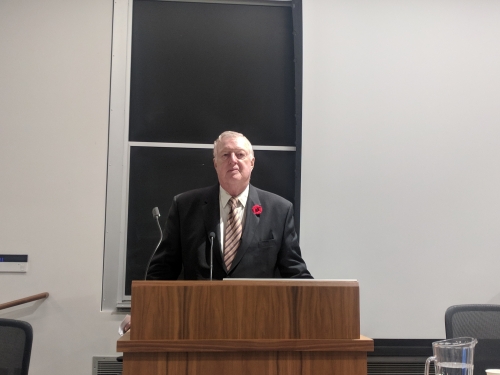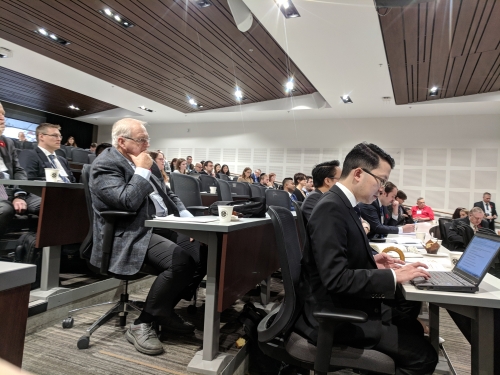"What is a patent? It's a ticket to sue!"
By German Andres Guberman and Amanda Wolczanski, JD students
Justice Roger Hughes gave a candid and engaging talk on the patent system, as part of the keynote for the seventh annual Patent Law Colloquium, organized by the Centre for Innovation Law and Policy. His self-proclaimed “rant” was an informal analysis of the patent system's cast of characters (including patent officers, judges and lawyers), deficiencies, and potential fixes.

Justice Hughes suggested a three-pronged approach to making the system work for everybody and better fulfill its public purpose: codifying legal documents electronically; controlling patent trolls; and reimagining how judges decide the undecidable.
The electronic codification of documents would bring the Department of Justice into the 21st century. In the words of Justice Hughes, the system is so out of date that “even Noah would be antique compared to what they got there.” Justice Hughes suggests levying fees from patent holders, using existing platforms to build a document sharing network, and engaging the Canadian Bar Association and the Intellectual Property Institute of Canada to implement the system in a timely manner.
“Controlling the troll,” should begin in patent offices. Trolls can assert patent rights because examiners are overly lenient. Justice Hughes suggested publicizing the names of individual examiners who allow trolls to fall through the cracks. It may also be useful to create a regulatory body, such as a patent and trademark college. One commentator from the audience suggested such a regulatory system could have a built-in dual responsibility, analogous to the obligation of lawyers to their client and the court: patent examiners should have an obligation to the patent applicant and the public. Patent trolls have tested the legitimacy of IP law, particularly in recent years. The responsibility of patent officers in this respect requires an assumption of responsibility, increased scrutiny and renewed vigour.

Finally, Justice Hughes commented on the “lonely” way in which judges decide patent cases, and decide the undecidable. A judge is often left alone to make pivotal decisions on the cutting edge of science and technology. There are obvious problems with this approach. Nobody except the people making the product are really up to speed on the latest science. Scientific backgrounds in the legal profession help, but they're not enough. Working with expert witnesses is tough. Finding the right (neutral) expert is tough. These concerns are not alleviated by the American model where juries deciding patent cases are often “half-asleep.”
The question about the patent is always “is what was done here really worthy of a 20 year monopoly?” Justice Hughes suggests that something should be done to better align the decision making process with the interests and subject matter at the heart of the patent system.


